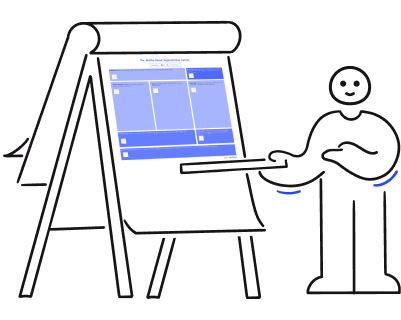Are you tired of starting over every time a new employee needs to be trained? Or even worse, whenever an employee leaves and takes their knowledge along, and not just their personal belongings?
Very often, this leads to time and productivity loss, and in the long run, it is quite unpleasant.
Setting up a system that allows you to preserve knowledge and make it accessible to others can help avoid all this trouble and facilitate the overall functioning of your business.
Sound knowledge management helps improve a company’s performance. In fact, it is an essential process that not only improves productivity and efficiency in the workplace, but also reduces costs, when well implemented.
Ok, so what does it mean, exactly?
Empower your organization with the skills-based canvas.

What's in this article
What is knowledge management?
Knowledge management is the process of collecting, storing, sharing and using knowledge within an organization. Organizational memory is crucial for a business, as it allows staff to have access to the right information at the right time, making everyone’s job easier.
6 benefits of knowledge management for businesses
It goes without saying that human capital is the most important asset of a business, and that is why it is essential to invest in its development and well-being.
Setting up a knowledge management system for your business can yield several competitive advantages. Obviously, knowledge management includes knowledge sharing as much as knowledge loss prevention.
Here are some of the main benefits of knowledge sharing in business :
1. Improved communication and collaboration
Knowledge management can lead to improved communication and collaboration within your organization, as it allows your employees to share their knowledge and ideas more easily.
2. Improved productivity
Allowing employees an easier access to the information and resources needed in their daily work leads to improved productivity.
3. Increased creativity and innovation
One way of making your business more innovative is teaching employees the skills they need and letting them explore new ideas.
4. Improved decision-making
Knowledge management can help improve decision-making by allowing employees to access the information they need in order to make informed decisions.
5. Cost reduction
By sharing knowledge, employees can work more efficiently, which reduces training costs and increases your company value.
6. Improved customer service
By having access to information relevant for their work, your employees can provide better customer service. Through shared knowledge, they can solve customer problems more effectively and efficiently.
Setting up a knowledge management system in 6 easy steps
Now that you are aware of the advantages of knowledge management, you might wonder how to implement it in your business. Here is how!
Step 1 : Identify the type of knowledge your business needs to manage
The first step is identifying the type of knowledge that your business needs to manage.
It is important to understand the differences between the three main types of knowledge:
- Explicit knowledge, which can easily be codified and shared through documents and databases;
- Implicit knowledge pertaining to know-how, acquired skills and experience. These are harder to formalize, since they are personal.
- Organizational knowledge, or the collective knowledge of an organization: its positioning, values, expertise, etc.
Does your company have any key employees you would like to ‘clone’? This reflection could help you identify the essential knowledge and skills of your organization!
Step 2 : Create a knowledge management strategy
The second step is creating a knowledge management strategy, which will help you determine how to gather, store, share and use this knowledge.
Your strategy should include :
- the type of knowledge to be managed;
- the objectives that knowledge management will help achieve;
- the ways in which the knowledge will be preserved and stored;
- the methods you will use to collect and share knowledge;
- the people in charge of knowledge management.
Step 3 : Gather the information
The next step is gathering the relevant information. This can be done through interviews, focus groups, surveys and other means. Once you have gathered the pertinent information, you need to organize and store it in a central place.
You will benefit from getting your employees as involved as possible in this process! You could even turn them into internal procedure champions and delegate expertise documentation to them.
Step 4 : Create a knowledge storing and sharing system
Knowledge storing and sharing is one of the pillars of the knowledge management process. It will help you use the knowledge within your organization.
However, in order to be productive, this system must be designed in a way that is easy to use and accessible to all employees. It must also allow for different access levels, so that only authorized users can view or edit information.
There are many types of knowledge management systems, including :
- Learning management systems;
- Online training systems;
- Databases;
- Document management systems;
- Content management systems.
Step 5 : Determine who will be responsible for knowledge management
The fifth step is determining who will be responsible for knowledge management. It could be a single person or a team of people. Once you have identified who is responsible, you must train them in knowledge management.
Step 6 : Evaluate the results
The last step is evaluating whether your knowledge management process is effective. This will help determine what has worked well or not so well, and which areas of your knowledge management system need improvement.
How can an LMS help set up a knowledge management system?
A learning management system (LMS) helps make business knowledge management more efficient, which leads to a more informed and productive workforce.
Since it is the focal point of a company’s training and development, an LMS provides a structure and a platform for the overall knowledge management strategy.
An LMS can also provide features that allow employee progress and performance tracking, making it a precious tool for identifying knowledge gaps and correcting them.
Workleap LMS was designed with the ultimate goal of making knowledge management and sharing easy and efficient. Request your demo now!
Discover, manage, and grow your team’s skills to unleash their potential and retain your rising stars.




